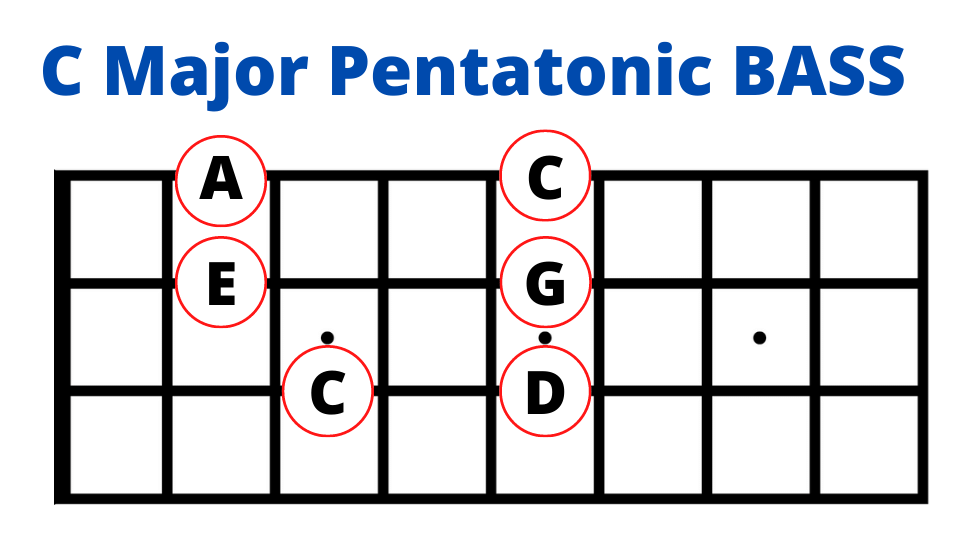The pentatonic scale is one of the most used scales in modern music today.
The pentatonic scale as its name indicates has only 5 notes of the seven notes of a major scale.
Of course I am talking about the major pentatonic, although we also have the minor pentatonic scale.
Today we are going to focus on the major pentatonic scale.
Here are some tips on how to use this scale on the electric bass.
If you can master the use of the pentatonic it will be a great help when creating bass lines.
The notes of the C major pentatonic scale for bass are:
C D E G A
Ways of using the pentatonic scale
Chord by chord
If you have a sequence of chords to go through, the only thing you should be concerned about is whether the chord is major or minor and then apply the corresponding pentatonic to it starting from its fundamental. In this way the pentatonic serves as a wildcard scale. We will always have 5 possible notes to play (plus their multiples in different octaves and the passing notes). If you have a chord for a very long passage I recommend that you deepen in applying the pentatonic in the whole neck.
Chord per chord
You can use the pentatonic on a chord not only from its fundamental, but also from other points. This will give a special sonority to the chord.
In minor chords, try to use the minor pentatonic from the 5th or the minor pentatonic from the major 2nd. That is, if you have a Dm, apart from the D minor pentatonic, you can use the A minor pentatonic and the E minor pentatonic.
In Maj7 chords, try playing the major pentatonic of its 5th. For example, in a CMaj7, apart from the C major pentatonic, you can use the G major pentatonic. This way with the pentatonic you will be adding the color of the major seventh, which does not happen if you use the pentatonic from the fundamental of the chord.
In seventh chords you can use the minor pentatonic from the 5th. For example, on a G7 try playing the D minor pentatonic.
Blues improvisation
The blues is a case apart. Although blues chords are major chords (seventh chords such as C7, G7 or A7) the blues sonority is based on what happens when you play a minor pentatonic on top of these chords. This contradiction is what makes the blues sound so special.
The trick I recommend to improvise on a 12 bar blues is: use the minor pentatonic of the I degree in the first 8 bars, the minor pentatonic of the V in the 9th bar and the minor pentatonic of the I again in bars 10, 11 and 12. To accompany a blues I do not recommend you to use this same trick if you do not want your colleagues to look at you badly, better tune yourself in the corresponding blues pattern.
Depending on the key of the song or passage
Those who control a little more and know the concet of tonality, will know that a tonality has 7 diatonic chords on which the vast majority of themes that we consider “commercial” are based.
For example, the 7 diatonic chords of the key of G major are:
G -Am-Bm-C-D -Em- F#m7b5 the latter is not used much
Something extremely useful that we can do with the pentatonic when we know the key of the theme is to place the fundamental of the pentatonic in the fundamental of the key. If the key is major we will apply the major pentatonic and if it is minor we will apply the minor pentatonic. It will be very useful to apply any of the schemes shown in the article in the previous issue of the magazine but I especially recommend the ones that go all the way around the neck. This pentatonic located in the fundamental of the key, we can call it the main pentatonic of the theme and we can always use it whatever the chord you are in.
The method to use this concept when you are playing bass accompanist, is to play the root of the chord you are in (to define the chord) and then whenever you want to put some filler notes, make them notes of the main pentatonic of the theme.
Try this harmonic Progression
| G | C | D | G |
|Bm | C | D | G |
This progression is in the key of G major, so the main pentatonic is G major.
When you play over the first chord G play the root note G and improvise a fill with the major pentatonic of G. When you are over the chord Bm play the root note B and improvise a fill with the major pentatonic of G. When you are over the chord C play the root note C and improvise again a fill with the major pentatonic of G and when you are over the chord D play the root note D and improvise again a fill with the major pentatonic of G.
It’s a very easy way to think while playing since you only have to worry about where the tonics of the chords are, the rest you get everything from a single scale. This way your bass line gains in cohesion and coherence and the choice of notes will always be harmonically correct.
This same principle can be used when you are soloing over a chord progression, but with the advantage that you don’t have to go through the tonic of the chords. If we take the above progression as an example, you only need to improvise on the G major pentatonic to get a great bass solo.

